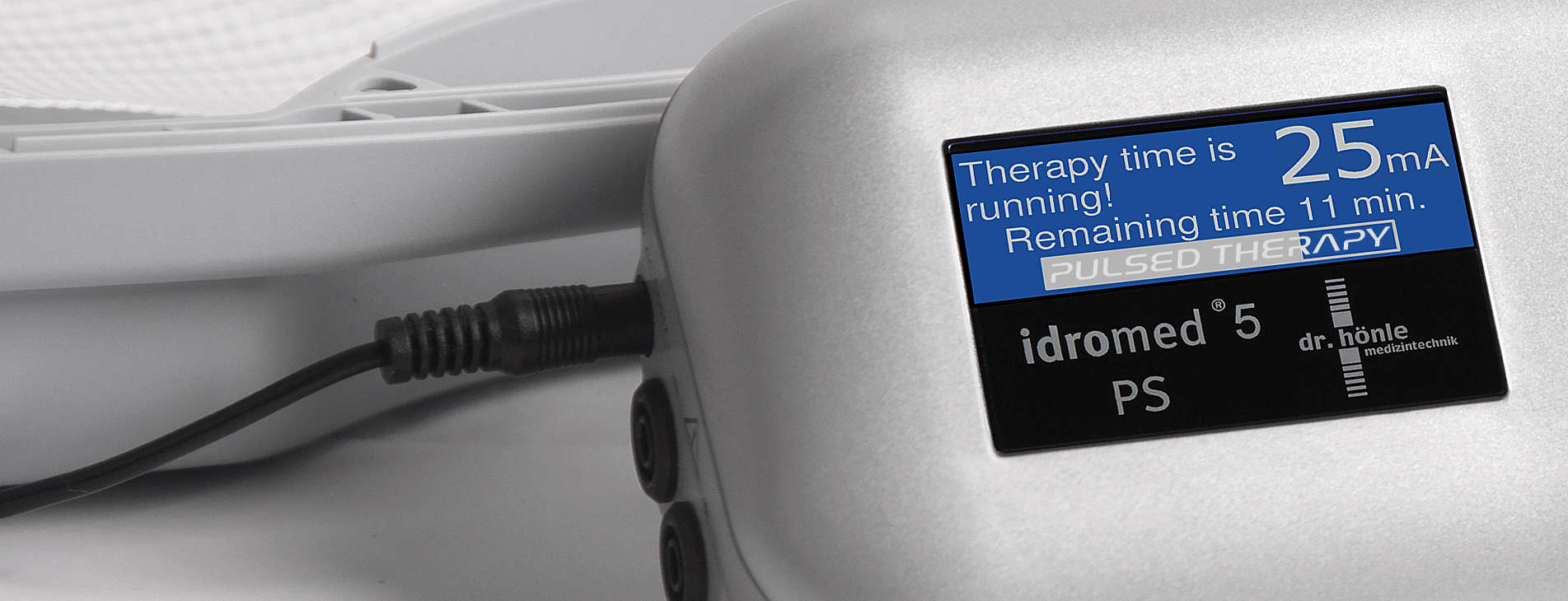Why we always recommend a pulsed current device
The pulsed current has decisive advantages.
- The treatment flow is barely noticeable
- You can set higher currents
- Skin irritations are rare
This enables shorter therapy sessions and / or longer breaks between the individual treatments.
Iontophoresis therapy: With this form of therapy against hyperhidrosis, a simple basic rule applies to the current perception (feeling of the current during the therapy):
Direct current = DC = strong current perception
Pulsed current = PC = gentle current perception.
Note the two basic rules:
1. Direct current and pulsed current are basically equally effective at the same median current strengths.
This means that a direct current device is just as effective at 12mA as a pulsed current device at 12mA.
2. The only difference is the perception of the treatment current.
Many users feel the flow of the direct current even at a low current level.
With a pulsed current device, you will therefore be able to set higher currents. The ideal current should feel soft and pleasant.

The gentle pulsed current allows many users to:
- Set higher currents and thereby significantly reduce the treatment time
- Enjoy a much more comfortable treatment experience
- Minimize skin irritations
- Or, in the best case, benefit from all three advantages at once
Direct current, pulsed current and variable pulsed current
For most users, the most effective current is the highest achievable current
Direct currents are considered to have a stronger effect. Where does that belief come from? One study demonstrated the following result: while treating with direct current, it took an average of 11 days for the effects to set in. The same 11 days were achieved when treating with pulsed current. The study described a lesser amount of skin irritation in the case of the pulsed current.
A normal alternating current had no effect on the excessive sweating.
However: you should only believe in statistics that you doctored yourself!
During the above study, a triangular current with 4.3 and 5.1 kilo Hertz was used. This is difficult to compare with today's "smooth" square-wave current at 10 kilo Hertz, such as supplied by Hidrex or Idromed.
Our experience and the feedback from our customers clearly show the following:
Pulsed current and variable pulsed current: Many users achieve a very good success with short treatment times.
Direct current: Many users (a significantly smaller number than those with PC) achieve a success with mostly longer treatment times.
This could indicate that the 10 kHz frequency is a lot easier to tolerate, and that today's pulsed current is also more pleasant and efficient than a triangular current.
The same is suggested by the following statement in the foreword of the study: in addition to a Hidrex device, "experimental" iontophoresis devices were used. It is unknown who built these devices.
The same study suggests that a treatment of the hands and feet will not be successful below 8 mA.
Those are values that cannot easily be achieved with direct currents.
With a pulsed and a variable pulsed current, the presumed hurdle of 8 mA is usually not a problem.
We cannot confirm such a "fixed" 8 mA hurdle from our experience. To our practical knowledge, these values are very individual and can range from a much lower to a much higher intensity.
Note:
However, it is obvious to us that a user is more likely to "crack" the personal hurdle with a pulsed or a variable pulsed current device, even if the required value ranges above 8 mA.
In summary:
Everyone needs a certain amount of electricity to be successful. Otherwise, one could just use a small battery instead of a professional powerful device.
As a result, the following facts apply to most iontophoresis user: Higher currents: The probability of success increases.
The good side effect: If the iontophoresis is successful, the treatment sessions are often reduced to fewer sessions per week and shorter treatment times. In short: the therapy becomes more efficient.
Effectiveness of iontophoresis
The reverse case:
If the current levels lie below one's required values, there is a high probability that the therapy will not lead to the desired result - no matter how frequent and how long the sessions are.
The pulsed current therapy is much more pleasant at the same averaged current strength. This means that much higher current values can be set with a pulsed current device than a direct current device. The pulsed current is easier to tolerate and sometimes completely imperceptible
This level of comfort has a positive effect on the success rate and required therapy time.
If the patient is highly resistant to the treatment current, the direct current can be used to reach the required maximum value. The treatment feeling is more intense, and skin irritations are more likely to occur.
Even for many long-term users who have become highly familiar with the current, a treatment of the feet with a direct current at 25 mA can be intense. Most of them can easily tolerate the same level with pulsed current.
What about hands and armpits?
The skin of the armpits is very thin and sensitive. It's certainly not a good idea to apply a hard direct current to this area. The armpit skin is very fragile and tender. There is no need for high currents, because the treatment area is not as large it is in other parts, e.g. the feet.
With a conventional direct current, it is often impossible to reach even two or three mA in these sensitive areas. With a pulsed current, this value is much higher.
The same argument can be made for the hands:
Often, small wounds may be found on the hands, and the nail beds are especially sensitive, which can quickly lead to a painful treatment feeling with a direct current.
Some background knowledge:
Earlier, we mentioned the "average" or "median" current. What does this mean exactly?
Iontophoresis devices typically indicate the maximum peak current. Of course, the pauses between the impulses is not indicated.
At a pulse width of 50%, the peak current of 25 mA translates into an average current of 12.5 mA. Because the pulse pause occupies 50% of the current, during which no electricity is supplied, the value is halved.
The variable pulsed current influences the level of the average current.
The guiding value for the same effect at 30 mA at 90% pulsed current is approximately 27 mA with a direct current. If you have reached the maximum possible current, then a treatment length that is prolonged by 10% would result in the same current dose.
Such high currents are usually not reachable with the direct current. 27 mA in direct current mode is an incredibly strong value.
In principle, this means: If you need more than 27 mA with a direct current to reduce the sweating to a natural level, then it would be difficult to achieve success with 90% pulsed current.
Test Service Iontophoresis with Pulsed Current
Trial and service: Still unsure about the pulsed current?
This is where our service comes into play: we offer individual exchanges of all types of devices.
You bought a pulsed current device from us and think the current is too soft? We will exchange it for a direct current device from our range.
All price differences must be settled, we pay for the postage!
Iontophoresis and the individual "current feeling"
Let's say our test person requires a level of 18mA to treat their sweaty feet successfully. They own a direct current iontophoresis machine. With this device, our test person can unfortunately only set a maximum of 10mA, i.e. 8mA less than is actually required.
Regardless of the frequency and length of this person's therapy sessions, one can assume that the therapy will not be successful.
In this example, a higher current is required to achieve an effect.
A pulsed current device would increase the chances that our test person could reach and exceed their personal minimum of 18 mA.
You may be wondering: how should someone know which treatment level they need, and how can they find out which device suits them best?
There is no way to find out for sure except by trying the therapy for yourself.
Please try a pulsed current device. In our opinion, you will be on the safer and more successful side.
You can of course also try the direct current device first. It may not cause any problems for you. Often, however, users cannot achieve the required current strength with a direct current device, or they make their own therapy unnecessarily uncomfortable.
Our conclusion on iontophoresis: As you can see, the therapy is not only a question of success, but also one of comfort.
We therefore always recommend pulsed current iontophoresis devices.
Our product recommendations are the following pulsed current device: Idromed 5 PS and the Hidrex ConnectION with variable pulsed current.
Find the differences: Hidrex or Idromed?
OUR PULSED CURRENT DEVICES
Switchable device
Direct current & 50% pulsed current
Pulsed current device
Automatic
VPC iontophoresis device
Variable pulsed current
Or choose a simple monthly rent
